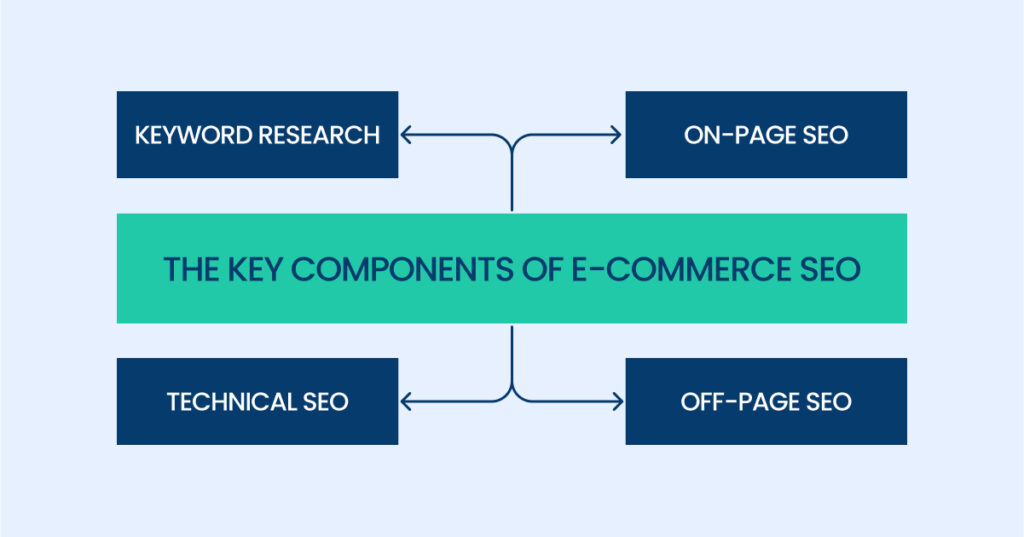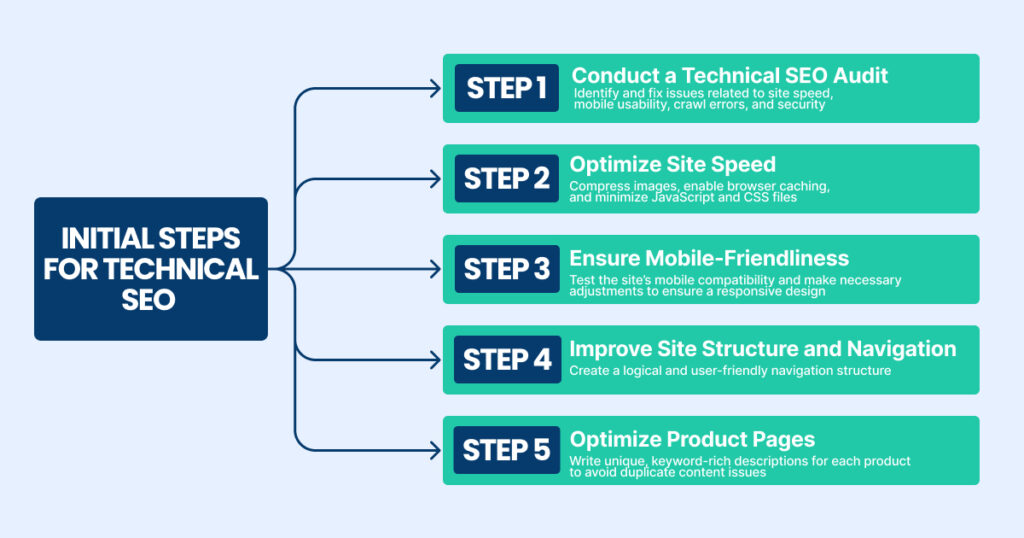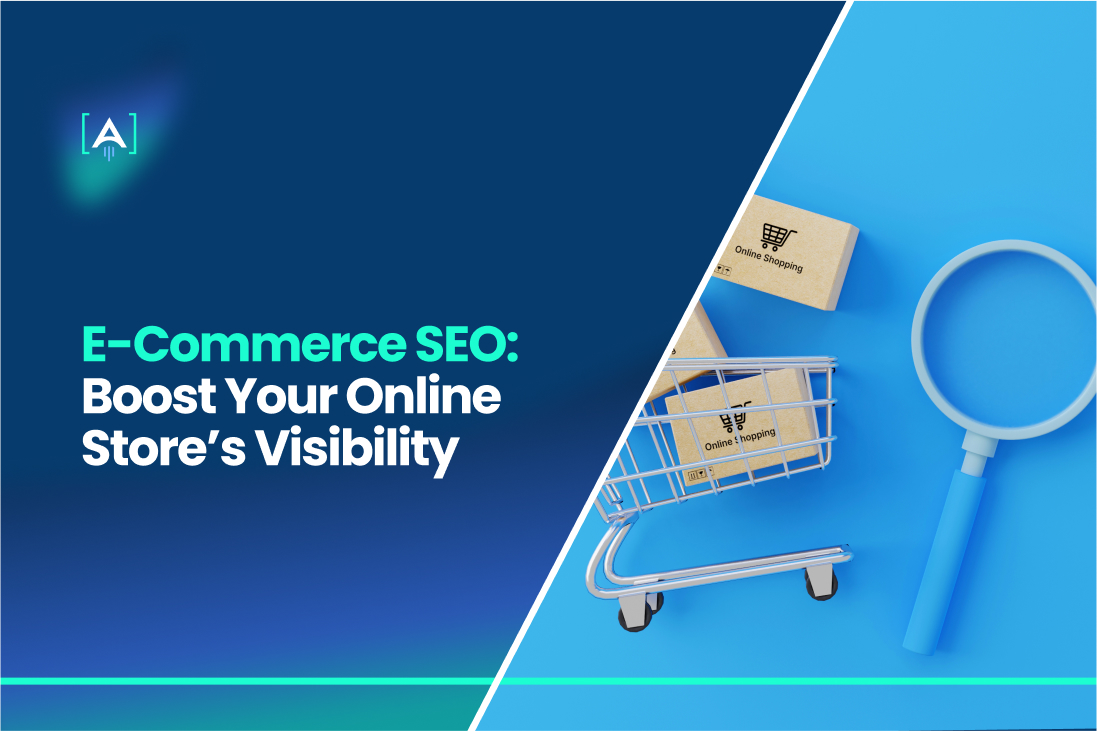Each Business wants to attract as many customers as possible. Yes, the digital era makes the process challenging enough.
Consequently, businesses must accept the new transformations and find corresponding solutions.
E-Commerce Marketing is the primary option.
According to the industry report, the E-commerce market in the United States is expected to register a 14.70 % CAGR between 2022-2027.
Source: MortorIntelligence
In this blog post, we will learn the basics of e-commerce, its components for developing the industry, and accepted approaches.
Understanding E-Commerce SEO
Understanding E-commerce SEO boils down to mastering the art of attracting customers through search engines.

Alternatively, Search engine optimization (SEO) is the method of boosting a website to increase its visibility on search engines, like Google, for correspondent search queries.
In e-commerce, SEO is crucial in driving organic traffic to an online store. It is essential for any business offering products or services online because it helps potential customers find their web pages more easily through search engines.
When applying an SEO strategy, businesses need to consider several factors.
First, it’s essential to comprehend the target audience and their search queries. This helps in creating relevant content that meets the needs of potential customers.
Businesses should also ensure their online store is user-friendly, with intuitive navigation, fast loading times, and mobile optimization, as these factors significantly affect SEO.
Why is E-Commerce SEO Essential?
SEO is the core of e-commerce businesses because it enhances visibility, drives organic traffic, and increases sales.
Without a solid SEO strategy, an online store may deal with ranking well on search engines, making it difficult for potential customers to discover their products or services online.
By understanding and using the key components of e-commerce SEO, businesses can improve their search engine rankings, attract more visitors, and achieve long-term success in the competitive digital marketplace.
E-commerce SEO vs. Traditional SEO | Benefits of E-commerce SEO
E-commerce SEO and traditional SEO both aim to improve a website’s visibility in Google search results through search engine optimization. However, they differ significantly in focus and execution.
Traditional SEO targets various content types, including blogs, informational articles, and service pages. In contrast, e-commerce SEO is specifically designed to optimize online stores, focusing on product and category pages to attract shoppers actively looking for specific items.
The Benefits of E-commerce SEO are:
Targeted Traffic:
- E-commerce SEO drives highly targeted traffic to an e-commerce website by optimizing product descriptions, meta tags, and URLs for relevant keywords. This increases the likelihood of conversions from visitors who are actively searching for specific products.
Enhanced User Experience:
- E-commerce SEO improves site navigation, loading speeds, and overall usability, making it easier for shoppers to find and purchase products. This not only satisfies search engine crawlers but also boosts customer satisfaction and retention.
Increased Visibility:
- Higher rankings in Google search results lead to more organic traffic. E-commerce SEO helps businesses achieve prominent positions in SERPs, reducing reliance on paid advertising and lowering customer acquisition costs.
Higher Click-Through Rates:
- Optimized e-commerce websites are more likely to attract clicks from search engine results pages (SERPs), increasing sales and revenue.
Building Trust and Credibility:
- Being at the top of Google search results signals to users that the e-commerce website is reputable and authoritative. This trust can translate into higher conversion rates and long-term customer loyalty.
Keyword Research and Optimization
Keyword research and optimization are fundamental aspects of e-commerce SEO that significantly impact an online business’s visibility and success.
Keywords are the words and expressions that prospective customers utilize in search engines when looking for products or services.
Good keywords for an e-commerce business are those that have high search volume, low competition and are highly relevant to the products offered.
Source: Semrush
Effective keyword research and optimization help search engines understand the content of web pages, making it easier for them to rank these pages in search results.
Components of Keyword Research and Optimization
Identifying Relevant Keywords:
This involves finding keywords directly related to the products or services the e-commerce business offers. The keywords should introduce the language and terms used by potential customers.
Analyzing Search Volume and Competition:
It is crucial to select keywords with a high search volume but relatively low competition. This ensures that the keywords can drive significant traffic without being too difficult to rank for.
Long-Tail Keywords:
Long-tail keywords are longer, more specific phrases that may have lower search volume but higher conversion rates. They are not that much competitive and can attract highly targeted traffic.
User Intent:
Understanding the intent behind the search queries is essential. Keywords should align with what users seek: information, a specific product, or a service.
Initial Steps for Keyword Research:
Brainstorming:
- Start by listing all the possible keywords and phrases relevant to the online business’s products or services.
Competitor Analysis:
- Analyze the keywords used by competitors. This can provide insights into which keywords drive traffic to their websites and reveal potential opportunities for your business.
Using SEO Tools:
- Utilize SEO tools such as Google Keyword Planner, SEMrush, Ahrefs, and Moz to find and analyze keywords. These tools provide data on search volume, competition, and trends, making it easier to identify the best keywords for optimization.
Refining Keyword List:
- Filter the list of keywords based on relevance, search volume, and competition. Focus on short-tail and long-tail keywords that align with the business goals.
On-Page Optimization:
- Once the keywords are selected, they should be incorporated into various web page elements, including the title tag, meta descriptions, headers, product descriptions, and image alt texts. This helps search engines understand the pages’ content and relevance.
Most Effective Tool
Among the various SEO tools available, Google Keyword Planner is often considered the most effective for keyword research.
It provides accurate data directly from Google, the most popular search engine, and offers insights into search volume trends, keyword competition, and suggested bid prices for PPC campaigns.
Additionally, it integrates seamlessly with Google Ads, making it a comprehensive tool for both organic and paid search strategies.
Technical SEO
Technical e-commerce SEO is fundamental for ensuring that an online retail website’s web pages are easily accessible and understandable to search engines.

Main Elements of Technical E-commerce SEO:
Website Speed and Performance:
- Fast loading times are crucial for both user experience and search rankings. Optimizing images, leveraging browser caching, and minimizing JavaScript and CSS files can significantly enhance site speed.
Mobile-Friendliness:
- With a significant portion of e-commerce traffic coming from mobile devices, it is vital to ensure the website is responsive and suggests a seamless experience across all devices.
Source: Semrush
Site Architecture:
- A well-structured site with clear navigation helps search engines understand the hierarchy and connection between pages. This includes using a logical URL structure and ensuring all pages are easily accessible.
Secure Website (HTTPS):
- Using HTTPS instead of HTTP ensures that data transmitted between the user’s browser and the server is encrypted and secure, which is also a ranking factor for search engines.
Structured Data:
- Implementing schema markup helps search engines understand the content of web pages better and can enhance search result listings with rich snippets.
Components of Technical E-commerce SEO:
Crawlability and Indexability:
- Ensuring that search engines can clearly access and index the site’s content involves checking for crawl errors, managing the crawl budget, and ensuring no important pages are blocked by the Robots.txt file.
Canonical Tags:
- Using canonical tags prevents duplicate content issues by pointing the preferred version of a web page to search engines.
XML Sitemap and Robots.txt:
- An XML sitemap assists search engines explore and index all the important pages on the site. The Robots.txt file guides search engines on which pages to crawl and which to ignore.
URL Structure:
- Creating clean, descriptive, and keyword-rich URLs that are convenient for both users and search engines to comprehend.
On-Page E-Commerce SEO
On-page SEO optimization is the magic touch you give to individual pages on your e-commerce website to make them more discoverable by search engines and, ultimately, more attractive to site visitors.
It’s about ensuring a seamless online shopping experience while strategically incorporating SEO tactics to improve your ranking in search results.
Components of On-Page E-Commerce SEO
Title Tags and Meta Descriptions:
Optimize title tags and meta descriptions with correspondent keywords that accurately describe each page’s content. This assists search engines in understanding the page’s topic and improves click-through rates from search results.
Keyword Integration:
Conduct keyword research to identify correspondent terms and phrases. Integrate these keywords naturally into product titles, descriptions, headers, and URLs to enhance SEO tactics.
High-Quality Content:
Provide detailed and unique content for each product page. This includes comprehensive product descriptions, usage instructions, and customer reviews, all optimized with target keywords.
Image Optimization:
Use high-quality images and optimize them with descriptive file names and alt texts. This assists search engines in understanding the image content and improves page load speed.
Internal Linking:
Make a strategic internal linking structure that connects related products and content within the site. This helps visitors easily navigate the site and find relevant information, enhancing their online shopping experience.
High-Quality Content Writing for E-commerce SEO
High-quality content writing is the cornerstone of a strong e-commerce SEO strategy. It’s not just about churning out words; it’s about crafting informative and engaging content that resonates with your target audience and search engines.
High-quality content writing is a cornerstone of effective e-commerce SEO. It significantly impacts an e-commerce site’s ability to attract and convert customers.
For an e-commerce company, producing high-quality content improves SEO rankings, enhances the user experience, and drives organic search results.
Source: Semrush
Components of High-Quality Content Writing
Keyword Research and Integration:
- Conduct thorough keyword research to know the relevant search terms. Integrate these keywords naturally into product descriptions, blog posts, meta tags, and other content to ensure the site ranks for relevant queries.
Detailed Product Descriptions:
- Craft unique and detailed product descriptions that provide valuable information to customers. Highlight the product’s key features, benefits, and uses, and incorporate high-quality images to enhance visual appeal.
Engaging Blog Content:
- Develop engaging blog content that addresses common questions, trends, and tips related to the products or industry. This attracts traffic and establishes the e-commerce company as an authority in its niche.
Customer Reviews and Testimonials:
- Engage with customer reviews and testimonials on product pages. These provide social proof and can positively influence purchasing decisions while also contributing to SEO rankings through user-generated content.
Visual Content and High-Quality Images:
- Use high-quality images, videos, and infographics to complement the written content. Visual content is crucial for e-commerce sites as it helps customers better understand the products and enhances the overall user experience.
Internal Linking
- Implement a strategic internal linking structure that leads visitors to related products and informative content, helping to keep them engaged and improving site navigation.
Building Links in E-Commerce
Link-building is vital to e-commerce SEO. It significantly enhances a site’s SEO by improving its authority and existence in search engine results.
Link building involves acquiring hyperlinks from other websites to your own, indicating to search engines that your content is valuable and trustworthy.
For e-commerce companies, effective link-building can boost SEO efforts and drive more traffic, making it easier for customers to shop online with just a few clicks. Here are the key components of link building in e-commerce SEO:
Components of Link Building in E-Commerce SEO
- Quality Backlinks:
- Focus on acquiring backlinks from reputable and relevant websites. High-quality backlinks are more productive than numerous low-quality ones and can significantly improve SEO.
- Content Marketing:
- Make valuable and shareable content, such as blog posts, infographics, and videos. This content can attract natural backlinks from other websites that find it useful and relevant.
- Guest Blogging:
- Write guest posts for reputable blogs in your industry. Include a link back to your e-commerce webpage in the content or author bio to gain valuable backlinks.
- Social Media Engagement:
- Promote your content actively on social media platforms. Social shares can indirectly contribute to link-building by increasing the visibility of your content.
- Influencer Collaborations:
- Partner with industry influencers who can link to your webpage from their blogs or social media profiles. Influencers can provide high-quality backlinks and drive traffic to your e-commerce site.
Measuring E-Commerce SEO Performance
Measuring SEO performance is essential for understanding your SEO efforts’ effectiveness and identifying areas for improvement.
After implementing initial SEO actions, it’s crucial to track and analyze various metrics to gauge the success of your strategy.
Main Elements to Check
Organic Traffic:
Organic traffic is regarding visitors who arrive at your e-commerce site through unpaid search results. The boost in organic traffic indicates that your SEO strategies effectively drive more visitors to your site.
Tools like Google Analytics can help to monitor changes in organic traffic over time.
Keyword Rankings:
Follow the performance of targeted keywords in search engine results. Use tools like Ahrefs, SEMrush, or Google Search Console to monitor keyword rankings and identify which keywords lead the most traffic to your site. Improvements in keyword rankings signify that your SEO efforts are worth it.
Click-Through Rate (CTR):
CTR shows the percentage of consumers who click on your site’s link in search engine results. A higher CTR shows that your meta titles and descriptions are challenging and relevant to search queries. Google Search Console provides insights into CTR for different keywords and pages.
Bounce Rate and Dwell Time:
Bounce rate shows the percentage of customers who fly from your site after viewing just one page.
Dwell time refers to how long visitors stay on your site before returning to the search results. A low bounce rate and high dwell time suggest visitors find your content engaging and relevant. Google Analytics can help track these metrics.
The conversion rate measures the percentage of visitors who complete a desired action, such as purchasing or signing up for a newsletter. Analyzing conversion rates aims to determine the effectiveness of your SEO strategy in driving traffic, sales, and leads.
Backlink Profile:
A strong backlink profile is the ways for SEO success. Analyze the quantity and quality of backlinks of your site using tools like Ahrefs or Moz. An increasing number of high-quality backlinks indicates that your content is authoritative and valued by other sites.
Initial Actions to Measure SEO Performance:
Use Google Analytics and Google Search Console:
These tools provide comprehensive data on your site’s performance, including traffic, user behavior, and search queries. Ensure they are correctly set up and linked to your e-commerce site.
Define Key Performance Indicators (KPIs):
Determine which metrics are most important for your business goals. Common SEO KPIs include organic traffic, keyword rankings, CTR, bounce rate, dwell time, and conversion rate.
Regularly Monitor and Analyze Data:
Consistently review your SEO performance data. Look for trends and patterns that indicate the success of your SEO strategies or highlight areas needing improvement.
Adjust and Optimize:
Based on your analysis, adjust your SEO tactics as needed. This might include optimizing content, improving site speed, enhancing mobile-friendliness, or refining keyword strategies.
Report and Communicate:
Create regular reports to communicate SEO performance to stakeholders. Apply to visual aids like charts and graphs to make data more accessible and understandable.
Partner with [A] Growth Agency For Your E-Commerce SEO
Excellence is our standard. If you strive to enhance your site’s visibility, drive organic traffic, and boost conversions, [A] Growth Agency, a trusted SEO agency is the right choice!
We cultivate a team of ‘A players’ – top-tier talents who bring passion and expertise to every challenge.
Our SEO professionals have extensive experience optimizing e-commerce sites across various industries. We stay updated with the latest SEO trends and algorithm changes to ensure your site remains competitive.
Partner with us and get the results you desire for the business.

